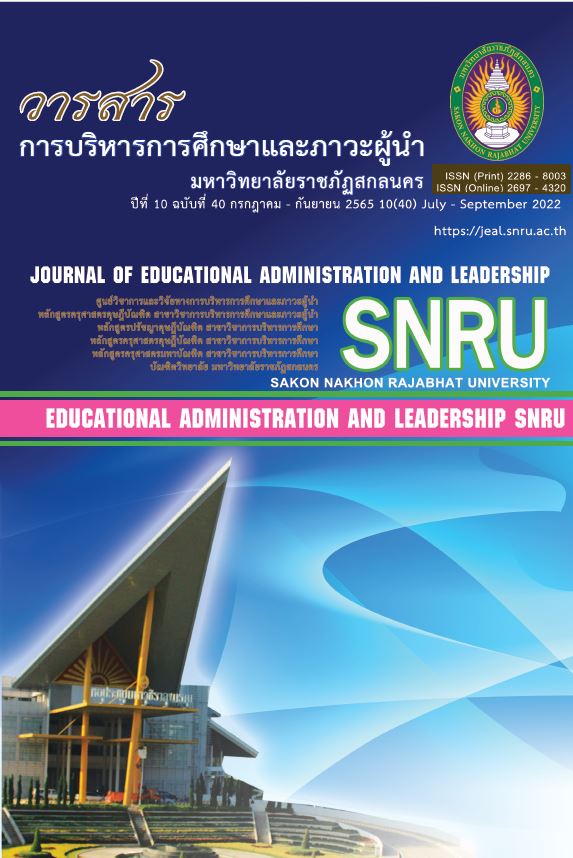

ปัจจัยทางการบริหารที่ส่งผลต่อประสิทธิผลของโรงเรียนสุขภาวะ ในสังกัดสำนักงานเขตพื้นที่การศึกษาประถมศึกษานครพนม เขต 1
The Administrative Factors Affecting the Effectiveness of Healthy Schools Under Nakhon Phanom Primary Educational Service Area Office 1
ผู้แต่ง
อดิศักดิ์ ลาศรีทัศน์, สายันต์ บุญใบ, ชรินดา พิมพบุตร
Author
Adisak Lasritas, Sayan Boonbai, Charinda Pimpabud
บทคัดย่อ
การวิจัยครั้งนี้มีความมุ่งหมายเพื่อศึกษา เปรียบเทียบ ปัจจัยทางการบริหาร ประสิทธิผลของโรงเรียนสุขภาวะตามความคิดเห็นของผู้บริหารโรงเรียน และครูผู้สอน จำแนกตามสถานภาพการดำรงตำแหน่ง ประสบการณ์ในการปฏิบัติงาน ลักษณะการเปิดสอน และขนาดโรงเรียน ศึกษาความสัมพันธ์ และหาอำนาจพยากรณ์ของปัจจัยทางการบริหาร ที่ส่งผลต่อประสิทธิผลของโรงเรียนสุขภาวะ ในสังกัดสำนักงานเขตพื้นที่การศึกษาประถมศึกษานครพนม เขต 1 กลุ่มตัวอย่าง ได้แก่ ผู้บริหารโรงเรียน จำนวน 23 คน และครูผู้สอน จำนวน 131 คน สังกัดสำนักงานเขตพื้นที่การศึกษาประถมศึกษานครพนม เขต 1 ปีการศึกษา 2564 กำหนดขนาดกลุ่มตัวอย่างใช้ตารางของ Krejcie and Morgan ด้วยวิธีการสุ่มแบบแบ่งชั้นภูมิ เครื่องมือที่ใช้ในการวิจัย คือ แบบสอบถามปัจจัยทางการบริหาร มีค่าอำนาจจำแนกอยู่ระหว่าง 0.38 – 0.77 และค่าความเชื่อมั่นเท่ากับ 0.95 และแบบสอบถามประสิทธิผลของโรงเรียนสุขภาวะ มีค่าอำนาจจำแนกอยู่ระหว่าง 0.39 – 0.74 และค่าความเชื่อมั่นเท่ากับ 0.93 สถิติที่ใช้ในการวิเคราะห์ข้อมูล ได้แก่ ร้อยละ ค่าเฉลี่ย และส่วนเบี่ยงเบนมาตรฐาน การทดสอบค่าที การวิเคราะห์ความแปรปรวนทางเดียว การวิเคราะห์ค่าสัมประสิทธิ์สหสัมพันธ์อย่างง่ายแบบเพียร์สัน และการวิเคราะห์ถดถอยพหุคูณทีละขั้นตอน โดยใช้วิธีวิเคราะห์ Stepwise
ผลการวิจัย พบว่า
1. ปัจจัยทางการบริหารของโรงเรียนสุขภาวะ โดยรวมอยู่ในระดับมาก
2. ประสิทธิผลของโรงเรียนสุขภาวะ โดยรวมอยู่ในระดับมาก
3. ปัจจัยทางการบริหารของโรงเรียนสุขภาวะ พบว่า จำแนกตามสถานภาพการดำรงตำแหน่ง โดยรวม แตกต่างกันอย่างมีนัยสำคัญทางสถิติที่ระดับ .01 จำแนกตามประสบการณ์ในการปฏิบัติงาน โดยรวม แตกต่างกันอย่างมีนัยสำคัญทางสถิติที่ระดับ .05 เมื่อจำแนกตามลักษณะการเปิดสอน และขนาดโรงเรียน พบว่า ปัจจัยทางการบริหารของโรงเรียนสุขภาวะ ไม่แตกต่างกัน
4. ประสิทธิผลของโรงเรียนสุขภาวะ จำแนกตามสถานภาพการดำรงตำแหน่ง แตกต่างกันอย่างมีนัยสำคัญทางสถิติที่ระดับ .05 เมื่อจำแนกตามประสบการณ์ในการปฏิบัติงาน ลักษณะการเปิดสอน และขนาดโรงเรียน พบว่า ประสิทธิผลของโรงเรียนสุขภาวะ ไม่แตกต่างกัน
5. ความสัมพันธ์ระหว่างปัจจัยทางการบริหารกับประสิทธิผลของโรงเรียนสุขภาวะ มีความสัมพันธ์ทางบวก อยู่ในระดับสูง อย่างมีนัยสำคัญทางสถิติที่ระดับ .01 โดยมีค่าสัมประสิทธิ์สหสัมพันธ์ (r=0.816)
6. ปัจจัยทางการบริหาร ที่สามารถพยากรณ์ประสิทธิผลของโรงเรียนสุขภาวะ อย่างมีนัยสำคัญทางสถิติที่ระดับ .01 จำนวน 2 ด้าน คือ ด้านบุคลากร และด้านการจัดการเรียนการสอน
7. แนวทางในการพัฒนาปัจจัยทางการบริหารที่ส่งผลต่อประสิทธิผลของโรงเรียนสุขภาวะ มีจำนวน 2 ด้าน คือ 1) ด้านบุคลากร โดยผู้บริหารต้องส่งเสริมสนับสนุนการพัฒนาความรู้ความสามารถของบุคลากรไม่ว่าจะเป็นการอบรม หรือสัมมนาทางวิชาการ พร้อมกับการสร้างข้อตกลง และกำหนดเป้าหมายทางการศึกษารวมกับบุคลากรและ 2) ด้านการจัดการเรียนการสอน ซึ่งผู้บริหารควรปรับกระบวนการการจัดการเรียนการสอนให้เป็นแบบ Active Learning ตลอดจนการบูรณาการเข้ากับนวัตกรรม จิตศึกษา PBL และ PLC
Abstract
The purposes of this study were: to examine and compare the administrative factors and the effectiveness of healthy schools as perceived by school administrators and teachers classified by positions, work experience, types of schools, and school sizes; to investigate the relationship and the predictive power of the administrative factors affecting the effectiveness of healthy school under Nakhon Phanom Primary Educational Service Area Office 1. The sample consisted of 23 school administrators and 131 teachers in schools under Nakhon Phanom Primary Educational Service Area Office 1 in the academic year 2021. The sample size was determined by using Krejcie and Morgan’s table and stratified random sampling. The research tools for data collection were sets of questionnaires centering on the administrative factors with the discriminative power ranging from 0.38 to 0.77 and the reliability of 0.95, and the effectiveness of healthy school questionnaires with the discriminative power ranging from 0.39 to 0.74 and the reliability of 0.93. Statistics for data analysis were percentage, mean, standard deviation, t-test, One-Way ANOVA, Pearson’s product – moment correlation coefficient, and Stepwise multiple regression analysis.
The findings were as follows:
1. The administrative factors of healthy schools were overall at a high level.
2. The effectiveness of healthy schools was overall at a high level.
3. The overall administrative factors of healthy schools classified by participants’ positions were different at the .01 level of significance, whereas in terms of work experience, there were different at the .05 level of. The overall administrative factors of healthy schools classified by types of schools and school sizes showed no differences
4. The overall effectiveness of healthy schools as classified by participants’ positions was different at the .05 level of significance, whereas in terms of work experience, types of schools and school sizes, the effectiveness of healthy schools showed no differences.
5. The relationship between the administrative factors and the effectiveness of healthy schools was positive at a high level with the .01 level of significance and a correlation coefficient of .816.
6. The administrative factors that could predict the effectiveness of healthy schools at the .01 level of significance consisted of two aspects: Personnel and Instructional management.
7. The proposed guidelines for developing administrative factors affecting the effectiveness of healthy schools included two aspects: 1) Personnel, school administrators must promote personnel professional development through trainings or academic seminars, and support personnel in creating an agreement and setting educational goals; and 2) Instructional Management, school administrators must adjust an instructional management process with active learning, innovation, psychological education, PBL, and PLC
คำสำคัญ
ปัจจัยทางการบริหาร, ประสิทธิผล, โรงเรียนสุขภาวะKeyword
Administrative Factors, School Effectiveness, Healthy SchoolsNotice: Undefined variable: dataSet in /var/www/html/ArticleView.php on line 116
Notice: Trying to access array offset on value of type null in /var/www/html/ArticleView.php on line 116
บทความทุกบทความเป็นลิขสิทธิ์ของ
Notice: Undefined variable: dataSet in /var/www/html/ArticleView.php on line 116
Notice: Trying to access array offset on value of type null in /var/www/html/ArticleView.php on line 116
เท่านั้น
กำลังออนไลน์: 23
วันนี้: 785
เมื่อวานนี้: 2,359
จำนวนครั้งการเข้าชม: 1,158,459
อาคารบัณฑิตวิทยาลัย ชั้น 2 ตำบลธาตุเชิงชุม อำเภอเมือง จังหวัดสกลนคร 47000
โทร/
แฟกซ์ 0-4297-0093
บรรณาธิการ: รองศาสตราจารย์ ดร.ไชยา ภาวะบุตร
ติดต่อ/สอบถาม: นายธีรเวทย์ เพียรธัญญกรณ์
โทร: 0-4297-0093